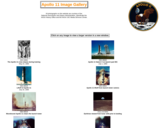38 Results
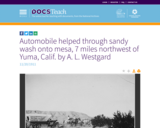
Photo taken 11/20/1911
- Subject:
- History/Social Sciences
- Material Type:
- Primary Source
- Provider:
- National Archives and Records Administration
- Provider Set:
- DocsTeach
- Date Added:
- 07/06/2022
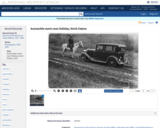
In this 1949 photo from the National Archives an automobile is shown with a man on horseback.
- Subject:
- History/Social Sciences
- Material Type:
- Primary Source
- Provider:
- National Archives and Records Administration
- Date Added:
- 07/06/2022
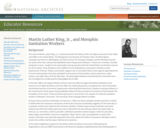
This lesson provides fliers and other documents related to the demonstration in Memphis on March 28, 1968. On that day, students near the end of the march broke windows of businesses. Looting ensued. The march was halted. King was deeply distressed by the violence. He and fellow leaders negotiated a commitment to nonviolence among disagreeing factions in Memphis, and another march was planned for April 8. On April 4, as he stepped out of his motel room to go to dinner, he was assassinated.
- Subject:
- History/Social Sciences
- Material Type:
- Lesson Plan
- Provider:
- National Archives and Records Administration
- Date Added:
- 07/06/2022
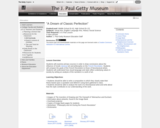
Students will examine primary sources in order to draw conclusions about the influence of Greek art and philosophy on the French Revolution. Students will compare the goals of the French Revolution to those of Neoclassical artists. Students will understand how visual language and style reflects underlying values in society by writing an analysis of the narrative in a work of art.
- Subject:
- Fine Arts
- Visual Art
- Material Type:
- Lesson Plan
- Visual Media
- Provider:
- J. Paul Getty Museum
- Provider Set:
- Getty Education
- Date Added:
- 05/03/2022

On July 26, 1948, President Harry S. Truman signed this executive order establishing the President's Committee on Equality of Treatment and Opportunity in the Armed Services, committing the U.S. government to integrating the segregated military. Read and see the document here.
- Subject:
- History/Social Sciences
- Material Type:
- Primary Source
- Reading
- Provider:
- National Archives and Records Administration
- Provider Set:
- www.ourdocs.gov
- Author:
- Harry S. Truman
- Date Added:
- 07/06/2022
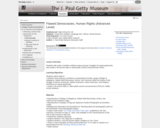
Students will create a timeline outlining various groups' struggles for equal opportunity and create a 30-second radio or video public service announcement (PSA).
- Subject:
- American History
- Fine Arts
- History/Social Sciences
- Material Type:
- Lesson Plan
- Visual Media
- Provider:
- J. Paul Getty Museum
- Provider Set:
- Getty Education
- Date Added:
- 05/03/2022
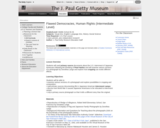
Students will read primary source documents about the U.S. internment of Japanese Americans following the bombing of Pearl Harbor and will examine various versions of a photograph by Dorothea Lange and explore how cropping can evoke different effects.
- Subject:
- American History
- Fine Arts
- History/Social Sciences
- Material Type:
- Lesson Plan
- Visual Media
- Provider:
- J. Paul Getty Museum
- Provider Set:
- Getty Education
- Date Added:
- 05/03/2022

Students will be able to critically identify key tipping points in the evolution of political parties. They will be able to connect this evolution to geographic elements and identify causation factors that led to this evolution. Key question: How did political parties impact the geography of the United States between 1792 and 1972? Contains links to student materials and teacher materials for creating lesson plans.
- Subject:
- American History
- Geography
- Government and Civics
- History/Social Sciences
- Material Type:
- Activity/Lab
- Lesson
- Primary Source
- Visual Media
- Provider:
- Virginia Geographic Alliance
- Provider Set:
- Placing Primary Sources Story Map Collection
- Author:
- Mace, Scott
- Date Added:
- 09/08/2017

Students examine primary resources, photographs by Dorothea Lange, and a U.S. map to understand the migrant experience during the Great Depression.
- Subject:
- American History
- Fine Arts
- History/Social Sciences
- Material Type:
- Lesson Plan
- Visual Media
- Provider:
- J. Paul Getty Museum
- Provider Set:
- Getty Education
- Date Added:
- 05/03/2022
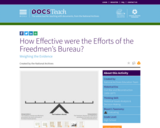
Students will analyze documents from the War Department’s Bureau of Refugees, Freedmen, and Abandoned Lands — better known as the Freedmen’s Bureau — that Congress established on March 3, 1865, as the Civil War was coming to an end. Using the scale in Weighing the Evidence, students will evaluate the effectiveness of the Freedmen’s Bureau in assisting formerly enslaved persons. Learning Objectives: Students will be able to identify and draw conclusions about the roles of the Freedmen’s Bureau (Bureau of Refugees, Freedmen, and Abandoned Lands), critically analyze primary sources, formulate opinions about the effectiveness of the Bureau, and back up their opinions verbally or in writing.
- Subject:
- History/Social Sciences
- Material Type:
- Activity/Lab
- Interactive
- Provider:
- National Archives and Records Administration
- Author:
- National Archives Education Team
- Date Added:
- 07/06/2022

Database of Hebrew and Arabic texts recovered by a US Army team in Iraq. Primary Resources/Authentic Texts. The restoration and preservation of these documents is explained.
- Subject:
- History/Social Sciences
- Material Type:
- Primary Source
- Provider:
- National Archives and Records Administration
- Date Added:
- 07/06/2022

This Story Map Journal emphasizes geography’s impact on United States’ strategy in fighting World War II in the Pacific. Students, through the use of Library of Congress resources explore geography’s impact on the average soldier in the Pacific. They will also chart the progress that the armed forces made in their attempt to hop over non-strategic islands in their attempts to get ever closer to the home islands of Japan. Based on the images obtained from the Library of Congress, students will be able to critically assess the toll that the geography of the Pacific took on soldiers. Contains links to student materials and teacher materials for creating lesson plans.
- Subject:
- American History
- Geography
- History/Social Sciences
- World History
- Material Type:
- Activity/Lab
- Lesson
- Primary Source
- Visual Media
- Provider:
- Virginia Geographic Alliance
- Provider Set:
- Placing Primary Sources Story Map Collection
- Author:
- Mace, Scott
- Date Added:
- 09/08/2018

This activity allows students to act as historians. The student will analyze various primary documents to determine the cause of "The Starving Time" in Jamestown, Virginia. Once the students have analyzed the sources, they will be asked to write a paragraph to explain their conclusion.
- Subject:
- American History
- Material Type:
- Activity/Lab
- Author:
- Laura Brown
- Date Added:
- 06/24/2020
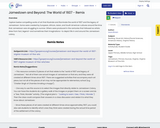
Explore twelve compelling works of art that illustrate and illuminate the world of 1607 and the legacy of Jamestown. Some were created by European, African, Asian, and South American cultures around the time that Jamestown was struggling to survive. Others were produced in the centuries that followed as artists drew from fact, legend—and sometimes their imaginations—to depict life in and around the Jamestown colony.
- Subject:
- American History
- History/Social Sciences
- Reading
- Virginia History
- Visual Art
- Material Type:
- Activity/Lab
- Student Guide
- Author:
- Laura Brown
- Date Added:
- 07/30/2020
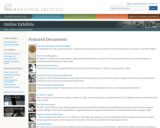
Magna Carta (Latin for Great Charter) is an Angevin charter originally issued in Latin in June 1215. The
Magna Carta was the first document forced onto a King of England by a group of his subjects in an attempt to limit his powers by law and protect their rights.
The charter is widely known throughout the English speaking world as an important part of the protracted historical process that led to the rule of constitutional law in England and beyond. Read a translation into English here.
- Subject:
- History/Social Sciences
- Material Type:
- Primary Source
- Reading
- Provider:
- National Archives and Records Administration
- Date Added:
- 07/06/2022
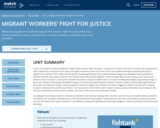
In this unit students study the California migrant farm workers' fight for justice. Lead by Cesar Chavez and Dolores Huerta, this time period is often referred to as the start of the Latino civil rights movement. Over the course of the unit students will explore what life was like for migrant farm workers in the 1960s and the barriers that prevented them from obtaining better wages and equitable working conditions. Students will then learn about how the farm workers were able to band together under the leadership of Larry Itliong, Cesar Chavez, and Dolores Huerta to launch a multi-year movement focused on using nonviolent tactics as a way of making meaningful, long-lasting change. In particular, students will analyze how different types of nonviolent protests (boycotts, pickets, marches, strikes, and fasting) helped educate the public and influence change. Understanding the history of migrant farm workers and their struggle for justice is important for helping students understand the world around them. It is important to note that this unit is based in history. Many of the ideas and concepts in this unit are connected to current events; however, the focus of the unit is on this period in history.
In reading, this unit helps students continue to build their informational reading skills. Over the course of the unit students will be pushed to think about the connection between two or more historical events and people. Unlike previous units, this unit contains a variety of primary sources and videos that require students to use different reading and speaking and listening strategies in order to synthesize and summarize key ideas.
- Subject:
- Communication and Multimodal Literacy
- English
- Fiction
- Reading
- Writing
- Material Type:
- Assessment
- Homework/Assignment
- Lesson Plan
- Provider:
- Match Fishtank
- Provider Set:
- Fishtank ELA
- Date Added:
- 01/01/2017

This Story Map Journal centers on World War One. This was a conflict on a level never before seen on the planet. Initially, the conflict was largely a European affair until an impressive piece of spy work by the British intelligence community brought the USA into the conflict. Key Questions: How and why did the U.S. become involved in the Great War? How was the United States able to stay out of the war initially? What were the factors that led to the U.S. declaration of war? What were the logistics behind U.S. mobilization? How did the U.S. strategy differ from that of the Allies? How and when did the war end? Contains links to student materials and teacher materials for creating lesson plans.
- Subject:
- American History
- Geography
- History/Social Sciences
- World History
- Material Type:
- Activity/Lab
- Lesson
- Primary Source
- Visual Media
- Provider:
- Virginia Geographic Alliance
- Provider Set:
- Placing Primary Sources Story Map Collection
- Author:
- Morris, Jared
- Date Added:
- 09/08/2018

Students will investigate the Dakota Access Pipeline and the timeline of events surrounding it. They will collaborate to research the impact this new technology has had, and continues to have, on Native People in that area, as well as create a decision making model to compare and contrast the supporting and opposing perspectives.
- Subject:
- Algorithms and Programming
- American History
- Computer Science
- Government and Civics
- Material Type:
- Lesson Plan
- Author:
- CodeVA Curriculum
- Date Added:
- 11/29/2022

This story map develops a historical context for the Civil Rights Movement, including Jim Crow Laws, Pullman Railroad workers, Great Migration, and restrictive covenants. The second main focus of the story map is the Civil Rights Movement itself. Students explore several map tours that highlight people, events, and organizations instrumental in bringing about legislation for equal rights during the 1950s-1960s. The story map concludes with a brief exploration of current civil rights injustices in the Unites States including issues such as same-sex marriage, Black Lives Matter and #MeToo movements. Key questions: How did the Civil Rights Movement change the United States? When did the Civil Rights Movement begin? Has it ended? What events characterized the Civil Rights Movement? What are the enduring influences and consequences of the Civil Rights Movement? Contains links to student materials and teacher materials for creating lesson plans.
- Subject:
- American History
- Geography
- History/Social Sciences
- Material Type:
- Activity/Lab
- Lesson
- Primary Source
- Visual Media
- Provider:
- Virginia Geographic Alliance
- Provider Set:
- Placing Primary Sources Story Map Collection
- Author:
- Schaefer, Kameron
- Date Added:
- 09/08/2018
